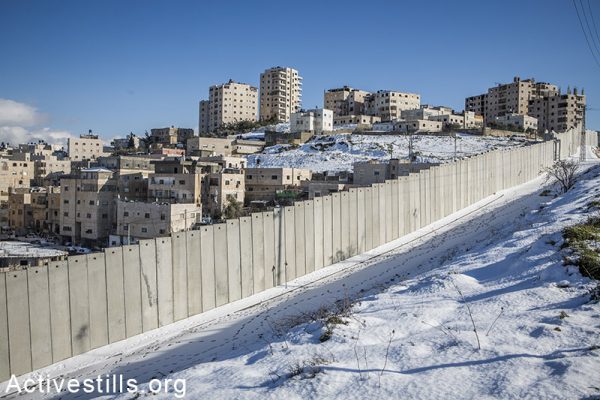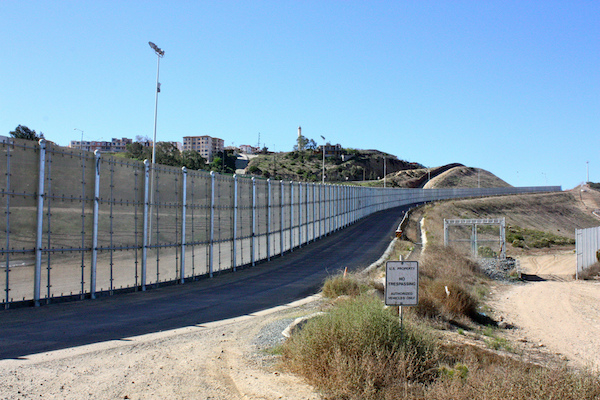Americans and Israelis need to resist not only border walls, but also the sentiments and systems that make them possible.
By Nadia Naser-Najjab

In promising to build a new wall along the American border with Mexico, U.S. President Donald Trump has openly sought to mine the deep racism and chauvinism that runs through parts of American society. Although it has been justified in practical terms, the wall has a particular symbolic significance: it renders a country increasingly unsure of itself and its place in the world, shaken as much by its own contradictions as by an external threat.
Given that the measure issues such a strong appeal to the basest of political impulses, it is perhaps unsurprising that it has attracted the support of a whole host of political undesirables, including Israeli Prime Minister Benjamin Netanyahu. On Saturday, Netanyahu took the opportunity to tweet his support, highlighting Israel’s own wall as a successful precedent.
Netanyahu was referring to the fence along Israel’s southern border, which drastically reduced the number of African asylum seekers entering the country via Egypt’s Sinai desert. However, in terms of the ideology behind the fence — keeping non-Jews out of the Jewish state — Netanyahu could just as easily have been referring to the West Bank separation wall.
The wall, on which work began in 2002, extends well east of the Green Line, effectively annexing around 10 percent of the West Bank. It divides Palestinian villages and towns, trapping over 200,000 Palestinian residents of East Jerusalem (creating a new Palestinian sub-category – ‘behind the wall’). It separates families and restricts the movement of Palestinian schoolchildren, teachers, university students and agricultural workers, meaning that some everyday activities have become almost impossible.
Successive Israeli governments have repeatedly made it clear that the Green Line, which is in fact the 1949 Armistice Line, will not determine the borders of the Israeli state. As such, it appears likely that the wall will instead provide the basis for the resolution of the settler issue — it is currently anticipated that around 98 percent of the settler population will reside in the areas that have been de facto annexed.

Despite Netanyahu’s pride in this creation, the legality of the wall has been repeatedly challenged — in October 2003, a proposed UN Security Council Resolution challenging its legal basis was vetoed by the US government; in 2004, the International Court of Justice provided an advisory opinion which stressed that the wall was incompatible with international law. The West Bank village of Bil’in won a smaller scale legal victory in 2007, when the Israeli High Court ruled that the wall’s proposed route was illegal.
It is a source of great regret that the tweeting Netanyahu missed the opportunity to draw further parallels between the U.S. and Israel, especially as these parallels present themselves to any objectively-minded observer. These encompass settler-colonialism (the destruction and displacement of an indigenous society), race relations (the challenges that confront black Americans and Palestinian citizens of Israel) and militarism (a domestic culture that elevates and celebrates state violence).
The wall establishes a clear binary distinction, separating the sanctified internal realm from the wild and barbarous hinterland. It serves as visual confirmation of the fact that Zionism is predicated upon a set of inclusions and exclusions. This point was reiterated in 1920, when David Ben-Gurion excluded Arab workers from the Histadrut, the General Federation of Jewish Workers in Palestine in 1920; it was similarly evidenced during the period 1948-1966, when Palestinian citizens of Israel lived under martial law. Inclusions and exclusions are evidenced as much within groups (in the divide between Ashkenazi and Mizrahi Jews) as between them (Israeli Jews and Palestinians resident in Israel).
Netanyahu fails to acknowledge that, in the long-term, the wall will not offer protection to America’s inhabitants, who are ultimately more at risk from their fellow citizens than from Mexican immigrants searching for a better life for themselves and for their children. The wall is as much a mental as a physical limitation, reflecting a pronounced inability to recognize that security will only be achieved when the fundamental rights and needs of all are met. Walls will only further embed the collective neurosis that appears to have taken hold of American and Israeli society.
It is impossible to escape this insight when the Boycott, Divestment and Sanctions (BDS) movement is characterized as an existential threat to Israel’s security or when Palestinians, living under an occupation that has endured for almost half a century, are asked to provide security guarantees to their nuclear-armed neighbor.
We saw it during the Oslo years, when Israeli politicians adopted ‘security’ as their mantra, never neglecting to turgidly chant it at each and every opportunity. In advancing security as an unconditional demand, they failed to register that successive Israeli governments had denied this same right to Palestinians. ‘Security’ came to represent a mental enclosure, a sustained refusal to engage with the demands of peace.

Of course, the wall is only a symptom of the problem, a visual depiction of sentiments and values that are deeply rooted within both societies. For Palestinians, the inhuman architecture of the wall embodies everything that the Israeli occupation stands for. It is the visual dimension of the occupation. In the same way, Trump and Netanyahu are the personification of deeply-held values within sections of their own societies.
This requires Israelis and Americans to engage in a more sustained analysis of the significance of demagogues such as Trump and Netanyahu. It would be all too easy to reduce them to the role of pantomime villains, providing them with a walk-on part into a dystopian drama. It is important to engage in a more sustained questioning, if only to allay the suspicion that liberals’ and progressives’ main objection to the likes of Netanyahu and Trump is that they display the full implications of their own positions.
After all, what is the essential difference between a border and a wall? Upon closer reflection, it would of course be insufficient to object to the wall without considering the broader structure to which it belongs. The wall is merely the visual and concrete embodiment of an apparatus (mental, discursive) which helps to sustain it.
To the same extent, it is necessary to go beyond Trump and Netanyahu and ask how their worldviews are embedded and reproduced within Zionism and American nationalism. To what extent does Trump articulate what is already there? Is Netanyahu the logical conclusion of Zionism? These are the essential questions that now need to be asked.
The contributions of the protestors are to be welcomed. They represent the best values of American society, reminding us that there is a considerable constituency for whom Trump does not speak. The question now is how this opposition to Trump can be constructed into a wider movement, opposing and challenging all forms of discrimination and intolerance. In response to the common cause found by demagogues across the globe, progressives should unite around the common causes of justice, equality and freedom — of which a free Palestine should be an intrinsic part — finding in them a reaffirmation of universal values and principles.
Dr. Nadia Naser-Najjab has a PhD in Middle East Studies and is an Associate Research Fellow at the European Center of Palestine Studies-Institute of Arab and Islamic Studies at the University of Exeter.

